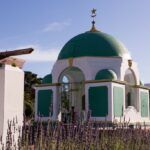Kramat of Sayed Mahmud
Kramat of Sayed Mahmud
A kramat is a shrine or grave of a Muslim holy man. There is a circle of about 20 of these shrines around Cape Town. Legend has it that these shrines protect Cape Town from natural disasters.
These holy men were often exiled to the Cape after resisting the tyranny of the Dutch who had invaded their countries, such as Malaysia, Java, and Indonesia. Some Muslims in the Cape had been sold into slavery. These were the people who began the Muslim communities in the Cape. However, it was only during the rule of the British that mosques were allowed to be built
The ship Polsbroek arrived in Cape Town in May 1668 after leaving Batavia four months earlier. On board were three political prisoners who had been banished to the Cape. They were from the west coast of Sumatra. One of the prisoners was sent to Robben Island and the other two worked in the company’s forest.
One of these prisoners was Sayed Mahmud, he was a spiritual and religious leader. He was one of the religious advisors who had been captured with Shiekh Abdurahman Matebe Shah and banished to Constantia. his shrine and that of Shiekh Abdurahman Matebe can be seen there today.
On Islam Hill in Groot Constantia is a shrine (kramat to get to it, you need to walk up a hill. When you get there please remove your shoes before entering as a sign of respect.

17 Summit Way Nova Constantia


